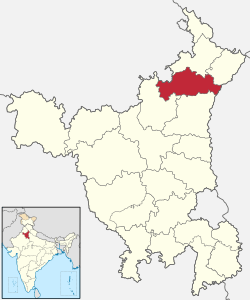Thanesar
Thanesar (sometimes called Thaneswar(basically is old Kurukshetra city) and, archaically, Sthanishvara) is a historic town and an important Hindu pilgrimage centre on the banks of the Saraswati River in the state of Haryana in northern India ,It is basically old Kurukshetra city Kurukshetra district, approximately 160 km northwest of Delhi, and Kurukshetra’s urban area now merges with (Thanesar city) Old Kurukshetra city. [2][3](note: old Kurukshetra city also called Thanesar city) both are same but people use to get confused between Thanesar city and Kurukshetra that they are different but let me clear Thanesar city or Kurukshetra city is same Thanesar city means old Kurukshetra city.
Thanesar (Old Kurukshetra City) | |
|---|---|
city | |
 | |
 Thanesar (Old Kurukshetra City) Location in Haryana, India 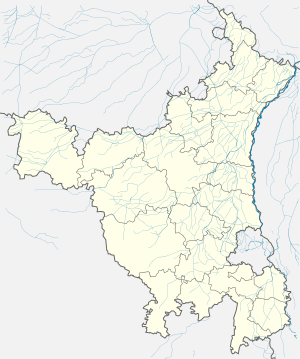 Thanesar (Old Kurukshetra City) Thanesar (Old Kurukshetra City) (Haryana) | |
| Coordinates: 29.965717°N 76.837006°E | |
| Country | |
| State | Haryana |
| District | Kurukshetra |
| Elevation | 232 m (761 ft) |
| Population (2011)[1] | |
| • Total | 154,962 |
| Languages | |
| • Official | Hindi, Punjabi |
| Time zone | UTC+5:30 (IST) |
| Vehicle registration | HR |
| Website | haryana |
Prabhakarvardhana was a ruler of Thanesar in the early seventh-century CE and was succeeded by his sons, Rajyavardhana and Harsha.[4]
Origin of name
The name Thanesar is derived from its name in Sanskrit, Sthanishvara which means Place/Abode of the Lord. (Sthana-Place/region, Ishvara-Lord)
History
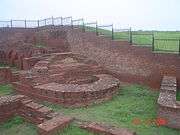
The present town of Thanesar is located on an ancient mound. The mound 1 km long and 750 m wide known as "Harsh ka Tila" (Mound of Harsha), west of Sheikh Chilli's Tomb complex in Thanesar. It has ruins of structures built during the reign of Harsha, 7th century CE. Amongst the archaeological finds from the mound include Painted Grey Ware shards in the pre-Kushana levels and Red Polished Ware from post Gupta period.[5][6]
In the post-Gupta period, the ancient city of Sthanishvara was the capital of the Vardhana dynasty, which ruled over a major part of North India during the late-6th and early-7th centuries. Prabhakarvardhana, fourth king of Vardhana dynasty and successor Adityavardhana, had his capital at Thanesar. After his death in 606 CE, his eldest son, Rajyavardhana, ascended the throne. Not long after, Rajyavardhana was murdered by a rival, which led to Harsha ascending to the throne at age 16. In the following years, he conquered much of North India, extended till Kamarupa, and eventually made Kannauj (in present Uttar Pradesh state) his capital, and ruled till 647 CE. His biography Harshacharita ("Deeds of Harsha") written by Sanskrit poet Banabhatta, describes his association with Thanesar, besides mentioning the defence wall, a moat and the palace with a two-storied Dhavalagriha (white mansion).[3][5][7]
The town was sacked by Mahmud of Ghazni in 1011.[8]
During Mughal era, the Battle of Thanesar also known as Battle of the Ascetics took place in summer of 1567, between Mughal Emperor Akbar and Rajputs near Thanesar on the banks of the Sarsawati Ghaggar River.
For much of the 18th century, Thanesar was under the suzerainty of the Maratha Empire, who collected revenue from the local rulers.
Thanesar came under the British rule after the British victory in the Second Anglo-Maratha War in 1805. Under the British, it was part of the Cis-Sutlej states province from 1809 to 1862. Thanesar was an obscure village until the 1950s. After the partition of India, a large refugee camp was set up here, which became the nucleus of a bustling commercial city. It grew so much that on 23 January 1973, a new district named Kurukshetra district was created, of which Thanesar was the main town. Now Thanesar is a Municipal Council. Thanesar is a Legislative Assembly of Haryana constituency within the Kurukshetra (Lok Sabha constituency).[9] People now tend, erroneously, to refer to Thanesar town as "Kurukshetra".
Majority of architectural remains including Karavan serai, cells, and various arched and vaulted structures date from the Mughal period. Building remains of a large palatial structure from the pre-Islamic era were also found with two distinct phases of construction which exposed brick covered drains and rooms situated around a central courtyard.[10]
Sack of Sthaneshwar by Mahmud of Gazni
Thanesar was sacked and many of its temples were destroyed by Mahmud of Ghazni.
'The city of Taneshar is highly venerated by Hindus. The idol of that place is called Cakrasvamin, i.e. the owner of the cakra, a weapon which we have already described. It is of bronze, and is nearly the size of a man. It is now lying in the hippodrome in Ghazna, together with the Lord of Somnath, which is a representation of the Mahadeva, called Linga."[11]
In the year A.H. 402 (A.D. 1011) Mehmood Gazini resolved on the conquest of Thanesur
, the most sacred Hindu place, in the kingdom of Hindoostan. It had reached the ears of the King that Thanesar was held in the same veneration by idolaters, as Mecca by the faithful; that they had there set up a number of idols, the principal of which they called Jugsoma, pretending that it had existed ever since the creation. Mahmood having reached Punjab, required, according to the subsisting treaty with the Hindu Shahi king Anandpal, that his army should not be molested on its march through his country. An embassy was accordingly sent to inform the Raja of his intentions, and desiring him to send safety guards into his towns and villages, which he would take care to be protected from the followers of his camp. Anandpal the Shahi king, agreeing to this proposal, prepared an entertainment for the reception of the King, at the same time issuing orders for all his subjects to supply the camp with every necessity of life.
The Raja's brother, with 2,000 horses was also sent to meet the army and to deliver the following message:
"My brother is the subject and tributary of the King of Gazni, but he begs permission to acquaint his Majesty, that Thanesar is the principal place of worship of the inhabitants of the country: that if it is required by the religion of Mahmood to subvert the religion of others, he has already acquitted himself of that duty, in the destruction of the temple of Nagrakote. But if he should be pleased to alter his resolution regarding Thanesar, Anandpal Tuar promises that the amount of the revenues of that country shall be annually paid to Mahmood, that a sum shall also be paid to reimburse him for the expense of his expedition, besides which, on his own part, he will present him with fifty elephants, and jewels to a considerable amount."
Mahmood replied, "The religion of the faithful inculcates the following tenet: ‘That in proportion as the tenets of the Prophet are diffused, and his followers exert themselves in the subversion of idolatry, so shall be their reward in heaven;’ that, therefore, it behooved him, with the assistance of God, to root out the "worship of idols" from the face of all India. “How then should he spare Thanesar?"[13]
This answer was communicated to Raja Anandpal Tuar of Delhi, who, resolving to oppose Sultan Mahmood, sent messengers throughout Hindoostan to acquaint the other rajas that Mahmood, without provocation, was marching with a vast army to destroy Thanesar, now under his immediate protection. He observed, that if a barrier was not expeditiously raised against this roaring torrent, the country of Hindoostan would be soon overwhelmed, and that it behooved them to unite their forces at Thanesar, to avert the impending calamity.
Mahmood, having reached Thanesar before the Hindus, had time to take measures for its defence; the city was plundered, the idols broken, and the idol Jugsoma was sent to Ghazni to be trodden underfoot. According to Hajy Mahommed Kandahary, a ruby was found in one of the temples weighing 450 miskals. It was allowed by everyone who saw it to be a wonder that had never been heard of. About the attack on Thanesar, Utbi wrote "The blood of the infidels flowed so copiously that the stream was discoloured, notwithstanding its purity, and people were unable to drink it."[14]
Mahmood, after the capture of Thanesar, was desirous of proceeding to Delhi. But his nobles told him that it would be impossible to keep possession of it, till he had rendered Multan a province of his own government and secured himself from all apprehension of Anundpal, the Hindushahi Raja of Lahore. The king resolved, therefore, for the present, to proceed no further, till he had accomplished these objects. Anundpal Shahi, however, conducted himself with so much policy and hospitality towards Mahmood, that he returned peaceably to Ghazni. On this occasion, the Mahmood's army brought to Ghazni 200,000 captives, and much wealth, so that the capital appeared like an Indian city, no soldier of the camp being without wealth, or without many slaves.
Mughal era
Sheikh Chilli's Tomb is located in Thanesar. This is tomb of Sufi Abd-ur-Rahim Abdul-Karim Abd-ur-Razak, popularly known by the name of Sheikh Chilli. He was Sufi master of Mughal Prince Dara Shikoh. The architectural plan shows considerable Persian influence. This tomb and attached Madarsa are associated with the Sufi Saint Abd-ur-Rahim.
Mughal Emperor Akbar, accompanied by his court historian Abul Fazl, visited Kurukshetra during the solar eclipse in 1567. Abul Fazl’s Akbarnama refers to the eclipse in Kurukshetra and the pilgrims bathing in the Brahma Sarovar. The French traveler François Bernier of the Mughal Emperor Shahjehan’s era also mentions the sacred baths at the Indus, Ganges and the sacred tanks of Thaneshwar (Kurukshetra) on the occasion of the solar eclipse.[15]
Sikh Guru's visits
Sikh Gurdwara is equally significant for the Sikhs. It was visited by Guru Amar Das, Guru Hargobind ji, Guru Har Rai ji, Guru Har Krishan ji, Guru Tegh Bahadur ji and Guru Gobind Singh ji. Four Gurdwaras are there in their memory: Gurdwara Dasvin Patshahi (Kurukshetra), Gurdwara Tisari and Satvin Patshahi (Kurukshetra) and Gurdwara Navin Patshahi (Kurukshetra). When Guru Amar Das Ji went on the 'long journey to Hardwar to see his old friends and acquaintances; and, as he went, scattered the blessings of Nam. On his way he halted at Thaneshwar, where the people asked why he composed hymns in the unknown Punjabi dialect and why not in Sanskrit-the only language in which great truths can be expressed. The Guru said, "Sanskrit, now that is no longer the people's tongue, is like well water-sufficient for the irrigation of a small tract of land; whereas Punjabi, being the living language of the people, even if it be nothing but a dialect, is as the rain, which falls in showers all over the country."
British era
For their participation in first war of independence, the Chaudharys and Lambardars of villages who participated in rebellion in Haryana were also deprived of their land and property, including 368 people of Hisar and Gurugram were hanged or transported for life, and fine was imposed on the people of Thanesar (Rs 2,35,000), Ambala (Rs. 25, 3541) and Rohtak (Rs. 63,000 mostly on Ranghars, Shaikhs and Muslim Kasai).[16]
Post-independence
An archaeological museum run by Archaeological Survey of India, was set up in Sheikh Chilli's Tomb complex. It consists of archaeological finds, like seals and sealings, terracotta figurines, plaques, ornaments, and swords from sites in nearby regions of Kurukshetra and Bhagwanpura. These objects are notably from Kushana (1st-3rd century CE), Gupta period (4th-6th CE), and from post Gupta period on Vardhana dynasty period (6th-7th CE).[17][18]
Religious significance
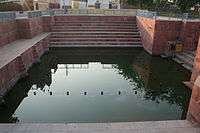
Thanesar derives its name from the words "Sthaneshwar" which means "Place of God." The Sthaneshwar Mahadev Temple, whose presiding deity is Lord Shiva, is believed to be place where the Pandavas with Krishna prayed to Lord Shiva and received his blessings for victory in the battle of Mahabharata.[19] It is the central and the most important place in the 48 kos parikrama of Kurukshetra. 1.5 km from Thanesar on Kurukshetra-Pehowa road lies Narkatari, the water tank named Bhishma Kund is believed to be the spot when Bhishma lay of the bed of arrows during the Mahabharata war.[20][21]
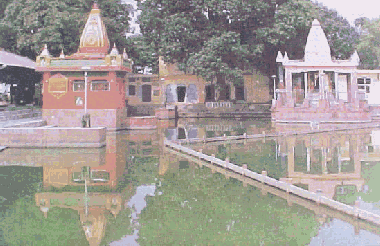
Kaleshwar Mahadev Temple and Dukha Bhanjan Mahadev Temples are the oldest temples of Thanesar. Other religious sites include the Brahma Sarovar,[22] Jyotisar, the Sannihit Sarovar, Gurdwara 6th Patashahi and the Devi Bhadrakali temple, which is counted among the 51 Shakti Peethas. The bathing-fair held here on the occurrence of a solar eclipse is said to be attended by half a million pilgrims.
Genealogy registers
Hindu genealogy registers at Thanesar are the genealogy registers of pilgrims maintained here.[23][24][25]
Modern Thanesar
The modern city of Thanesar is an important educational center; it is home to Kurukshetra University, the National Institute of Technology, Kurukshetra (Formerly Regional Engineering College), University Institute of Engineering and Technology (UIET), Kurukshetra University and world's first AYUSH University Shri Krishna AYUSH University. A public school namely Gita Niketan, opposite old Rudra talkies, on salarpur road. The University Institute of Engineering and Technology (U.I.E.T.) is situated in lush green campus of Kurukshetra University with about 1000 students on its roll. It has grown into a big institute with excellent placement record right from its inception. The Kurukshetra Institute of Technology & Management (KITM) is located 10 km from Kurukshetra University on Pehowa road, near Bhor Saidan village. Thanesar now has a Municipal Council from 1994. In 1994 the municipal elections were conducted by the state government after a long time.
Geography
Thanesar is located at 29.98°N 76.82°E.[26] It has an average elevation of 232 metres (761 feet).
Demographics
As of 2011 census of India,[27] Thanesar had a population of 154,962.[1] Males constitute 55% of the population and females 45% (83,655 - 71,307). Thanesar has an average literacy rate of 85.73%, higher than the national average of 74.04: male literacy is 89.89%, and female literacy is 80.85%.[1] In Thanesar, 12% of the population is under 6 years of age.
See also
- Ror community
- Tatka Village
References
- "Cities having population 1 lakh and above, Census 2011" (PDF). Census of India, 2011. p. 1. Retrieved 9 August 2014.
- James G. Lochtefeld (2002). The Illustrated Encyclopedia of Hinduism: N-Z. The Rosen Publishing Group. pp. 694. ISBN 978-0-8239-3180-4.
- "Sthanvishvara (historical region, India)". Encyclopædia Britannica. Retrieved 9 August 2014.
- Balaji Sadasivan (2011). The Dancing Girl: A History of Early India. Institute of Southeast Asian Studies. pp. 110–. ISBN 978-981-4311-67-0.
- "Sheikh Chilli's Tomb, Thanesar". Archaeological Survey of India. Retrieved 9 August 2014.
- "Harsh Ka Tila". Kurukshetra district website. Retrieved 8 August 2014.
- "Harsha (Indian emperor)". Encyclopædia Britannica. Retrieved 9 August 2014.
- "Kurukshetra (India)". Encyclopædia Britannica. Retrieved 9 August 2014.
- "Parliamentary/Assembly Constituency wise Electors in Final Roll 2009" (PDF). Chief Electoral Officer, Haryana. Archived from the original (PDF) on 9 April 2009.
- Pande, B.M. (2016). textsThanesar. Archaeological Survey of India. pp. 19–21.
- Abu Rihan Muhammad bin Ahmad al-Biruni al-Khwarizmi, Tarikhu'l-Hind
- Farishta Vo1. Page 29 Translation by John Briggs.
- Lopez Jr., Donald S. (2013). "1". From Stone to Flesh: A Short History of the Buddha. University of Chicago Press. p. 55. ISBN 9780226493206.
- "The History of India".
- "Solar Eclipse at Kurukshetra" Archived 24 July 2009 at the Wayback Machine
- Satish Chandra Mittal, 1986, Haryana, a Historical Perspective, p58.
- "Archaeological Museum, Thanesar". Archaeological Survey of India. Retrieved 9 August 2014.
- "Thanesar Archaeological Site Museum". Haryana Tourism Corporation Limited. Retrieved 9 August 2014.
- Dev Prasad (2010). Krishna: A Journey through the Lands & Legends of Krishna. Jaico Publishing House. pp. 216–. ISBN 978-81-8495-170-7.
- M.R. Biju (1 January 2006). Sustainable Dimensions Of Tourism Management. Mittal Publications. pp. 28–. ISBN 978-81-8324-129-8.
- Narkatari Kurukshetra district website.
- "Religious Places in Kurukshetra - Brahma Sarovar". Kurukshetra district website. Retrieved 8 August 2014.
- Tracing your Asian roots www.overseasindian.in.
- Hindu Pilgrimage Marriage Records www.movinghere.org.uk.
- 10 Places Across The World That Help You Trace Your Ancestors, India Times, 29 Jan 2016.
- Falling Rain Genomics, Inc - Thanesar
- "Census of India 2001: Data from the 2001 Census, including cities, villages and towns (Provisional)". Census Commission of India. Archived from the original on 16 June 2004. Retrieved 1 November 2008.
Bibliography
- Banabhatta (1897). The Harsa-carita of Bana. Translated by E. B. Cowell; F. W. Thomas. London : Royal Asiatic Society.
| Wikiquote has quotations related to: Thanesar |
